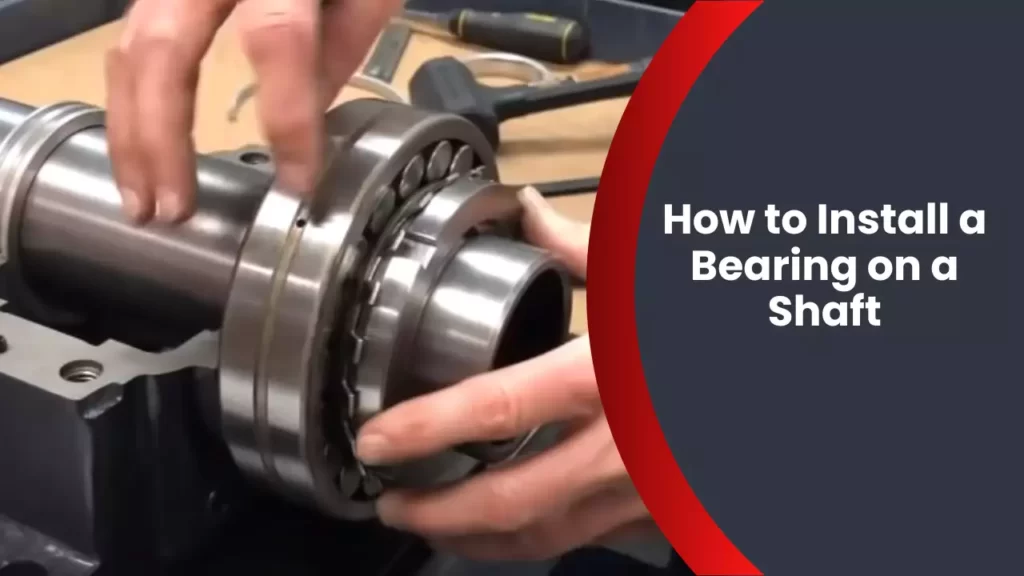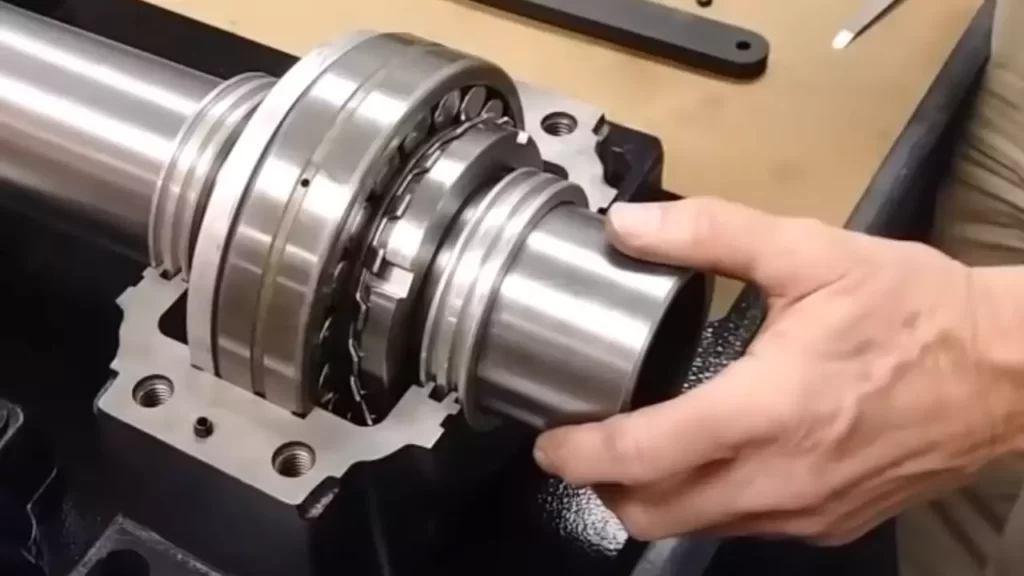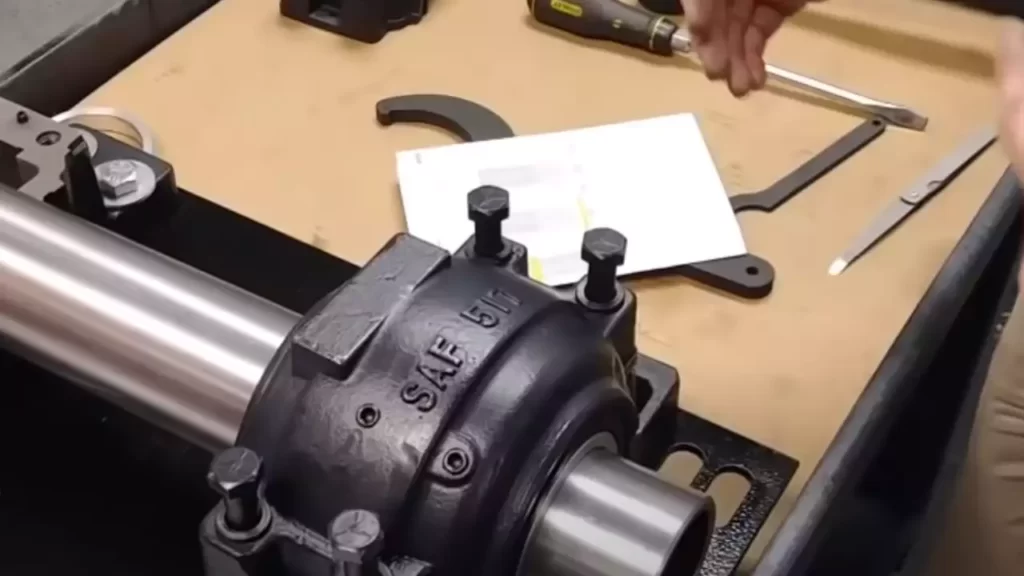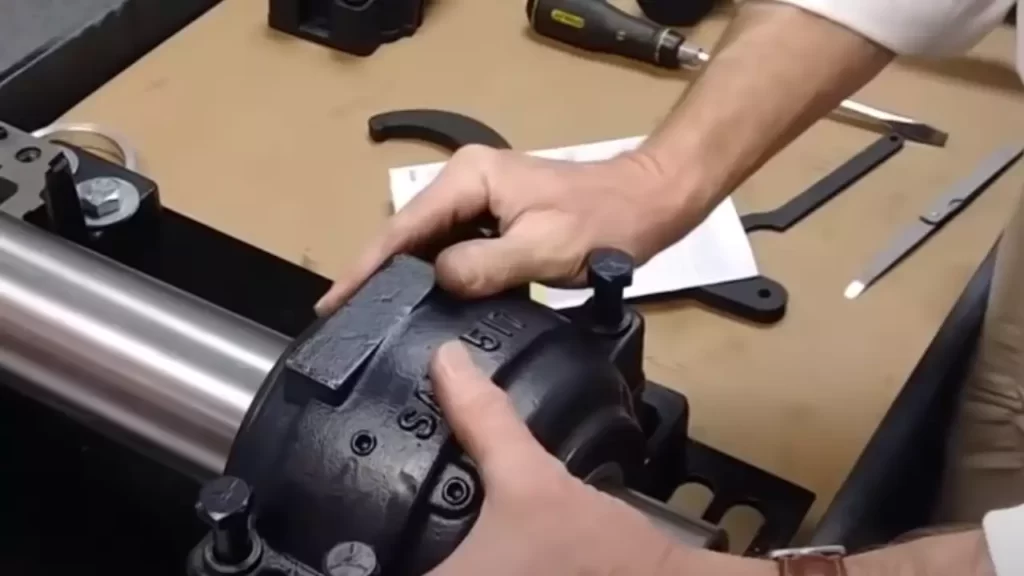To install a bearing on a shaft, align the bearing with the shaft, apply a thin layer of lubricant, and gently tap the bearing onto the shaft using a hammer or a press tool. Installing a bearing on a shaft is an essential process in various industries, such as manufacturing and automotive.
Bearings are key components that reduce friction between moving parts, ensuring smooth operation and longevity. However, the installation process requires care and precision to ensure proper functioning. This article will guide you on how to install a bearing on a shaft effectively, ensuring a secure fit and optimal performance.
Following these steps will help you carry out the process easily and avoid any potential damage to the bearing or shaft.
Understanding The Basics Of Bearings And Shafts
When it comes to machinery, bearings play a crucial role in ensuring smooth and efficient operation. A bearing is a mechanical component that reduces friction between moving parts in a machine. It allows for rotational or linear movement while minimizing resistance and wear.
The significance of a properly installed bearing on a shaft cannot be overstated. The bearing acts as a support for the shaft, keeping it aligned and reducing friction. A well-installed bearing ensures that the shaft rotates smoothly and evenly, preventing excessive wear and tear on both the bearing and the shaft itself.
What is a bearing and what is its role in machinery?
A bearing, in simple terms, is a machine component that supports and reduces friction between moving parts. It allows for smooth motion by enabling rotational or linear movement. Bearings are found in various applications, from automobiles and industrial machinery to household appliances and electronic devices.
The significance of a properly installed bearing on a shaft
Proper installation of a bearing on a shaft is crucial for optimal performance and longevity of the machinery. A well-installed bearing ensures that the shaft rotates smoothly and evenly, minimizing friction and wear. It also helps maintain alignment between the bearing and the shaft, preventing misalignment issues that can lead to excessive stress and premature failure of both components.
Different types of bearings and their applications
There are various types of bearings, each designed for specific applications and operating conditions. Some common types include:
- Ball Bearings: These bearings use balls to reduce friction and support both radial and axial loads. They are commonly used in applications that require high-speed rotation, such as motors, fans, and automotive wheels.
- Roller Bearings: Roller bearings utilize cylindrical, tapered, or spherical rolling elements to support heavy radial and axial loads. They are commonly found in heavy machinery, such as crushers, conveyors, and construction equipment.
- Plain Bearings: Also known as bushings or sleeve bearings, plain bearings consist of a shaft rotating inside a stationary sleeve. They are used in applications that require low-speed and low-friction operation, such as hinges, pivots, and sliding surfaces.
- Thrust Bearings: Thrust bearings are designed to handle axial loads in one direction and are often used in applications that involve high axial forces, such as automotive transmissions and gearboxes.
Considerations when selecting a bearing for a specific shaft
Choosing the right bearing for a specific shaft requires careful consideration of several factors, including:
- Load Capacity: The bearing must be able to handle the expected radial and axial loads that will be exerted on the shaft.
- Speed: The bearing must be rated for the anticipated rotational speed of the shaft to avoid overheating or premature failure.
- Environment: Consider the operating conditions, including temperature, moisture, and the presence of chemicals or contaminants, and select a bearing that can withstand those conditions.
- Size and Fit: Ensure that the bearing has the correct dimensions and fits securely on the shaft to maintain proper alignment and minimize vibration.
In conclusion, understanding the basics of bearings and shafts is essential for efficient machinery operation. Proper installation of a bearing on a shaft is crucial for minimizing friction, wear, and premature failure. By selecting the appropriate bearing type and considering key factors, one can ensure optimal performance and longevity of the machinery.

Preparing The Shaft For Bearing Installation
Installing a bearing on a shaft is a critical step in ensuring smooth operation of machinery. The shaft serves as the foundation on which the bearing sits, absorbing and transferring loads efficiently. To ensure a successful bearing installation, it is essential to prepare the shaft properly. This involves evaluating its condition, cleaning it thoroughly, measuring its diameter, and applying lubrication for optimal performance. In this section, we will dive into each of these steps, providing you with a comprehensive guide on how to prepare the shaft for bearing installation.
Evaluating the condition of the shaft before installing the bearing
Before proceeding with the bearing installation, it is crucial to assess the condition of the shaft. Look for any signs of wear, corrosion, or surface imperfections that could compromise the performance of the bearing. Check for any visible damage or irregularities such as dents, scratches, or pitting. If the shaft appears to be damaged, it is recommended to consult a professional or replace the shaft altogether. A smooth and undamaged shaft surface is essential for ensuring a proper fit and long-lasting performance of the bearing.
Cleaning and removing debris from the shaft surface
Once the condition of the shaft is evaluated, it’s time to clean the surface thoroughly. Remove any dirt, dust, or debris that may have accumulated on the shaft. Use a clean cloth or a mild solvent to wipe away any contaminants. Ensure that the shaft is completely dry before proceeding with the installation. Cleaning the shaft surface ensures that there are no particles that can affect the bearing’s functionality or cause premature wear and tear.
Measuring the shaft diameter and tolerance requirements
Accurate measurement of the shaft diameter is crucial for selecting the right bearing and achieving a proper fit. Using a caliper or similar measuring tool, carefully determine the shaft’s diameter at various points along its length. Take multiple measurements to account for any variations. Additionally, consider the tolerance requirements specified by the bearing manufacturer. The tolerance ensures that the bearing fits securely without excessive looseness or tightness. This measurement ensures a precise match between the shaft and bearing, optimizing performance and reducing the risk of failure.
Applying lubrication to the shaft for smooth installation
Lubrication plays a vital role in the smooth operation of the bearing and prolonging its lifespan. Before installing the bearing, apply a suitable lubricant to the shaft surface. The lubrication forms a thin film between the shaft and bearing, reducing friction and minimizing heat generation. It also helps in preventing rust and corrosion while facilitating easy installation. Apply the lubricant evenly along the length of the shaft, ensuring complete coverage. Be cautious not to over-apply as excess lubrication can cause friction and attract more contaminants. Proper lubrication allows the bearing to operate seamlessly and enhances its overall performance.
By following these steps and ensuring proper preparation of the shaft, you can lay the foundation for a successful bearing installation. A well-prepared shaft promotes optimal performance, reduces the risk of premature wear, and increases the lifespan of the bearing. Now that we have covered the basics of preparing the shaft, it’s time to move on to the next phase of installing the bearing itself.

Installing The Bearing On The Shaft
Properly installing a bearing on a shaft is crucial for ensuring smooth and efficient operation of mechanical systems. To achieve this, you need to focus on several important factors: properly aligning the bearing with the shaft, ensuring a secure fit, using the appropriate tools, and applying controlled force to seat the bearing onto the shaft.
Properly aligning the bearing with the shaft
Before you begin the installation process, it is essential to ensure that the bearing is properly aligned with the shaft. Misalignment can cause excessive wear and damage to both the bearing and the shaft. To align the bearing correctly, follow these steps:
- Inspect the bearing and shaft for any dirt or debris that could affect alignment.
- Position the bearing on the shaft, making sure it is centered and aligned with any keyways or slots present.
- Check the manufacturer’s specifications for any specific alignment requirements, such as angular misalignment limits.
Ensuring the bearing fits securely onto the shaft
To ensure the bearing fits securely onto the shaft, proper fitment is essential. A loose fit can lead to excessive vibration and premature failure, while a tight fit can cause unnecessary stress and damage. Follow these steps to ensure a secure fit:
- Measure the diameter of the shaft and the inner diameter of the bearing to ensure compatibility.
- Clean both the shaft and the bearing bore of any contaminants that could hinder proper fitment.
- Apply a thin layer of lubricant to the shaft to ease installation.
- Gently slide the bearing onto the shaft, ensuring it moves smoothly and fits snugly.
Using the appropriate tools for installation
Using the right tools is vital for a successful bearing installation. Here are some tools commonly used for this purpose:
- Bearing puller: This tool helps remove bearings from shafts quickly and safely.
- Alignment tool: Used to align the bearing and shaft accurately.
- Bearing heater: A heater is used to expand the bearing, allowing for easier installation onto the shaft.
- Socket wrench: A socket wrench is often used to tighten the retaining nut or bolts to secure the bearing.
Applying controlled force to seat the bearing onto the shaft
Applying controlled force during the installation process is crucial to prevent damage to the bearing or shaft. Follow these steps:
- Identify the appropriate seating force recommended by the bearing manufacturer.
- Use a hydraulic press or an installation tool designed for applying controlled force.
- Slowly and evenly apply force until the bearing is seated properly.
- Regularly check the alignment and fitment during the installation process.
- Once the bearing is securely seated, tighten any retaining nuts or bolts according to the manufacturer’s specifications.
Installing a bearing on a shaft correctly is a critical step in ensuring the smooth and reliable operation of mechanical equipment. By following the steps outlined in this guide and utilizing the appropriate tools, you can achieve a secure fitment and prevent premature failures. Take the time to properly align the bearing, ensure a secure fit, use the right tools, and apply controlled force for a successful installation.

Securing The Bearing On The Shaft
Methods of securing the bearing to prevent slippage
Securing the bearing on the shaft is a crucial step in the installation process to ensure proper functioning and prevent any unwanted slippage. There are several effective methods you can employ to secure the bearing firmly in place:
- Tightening the shaft collar: The first method involves using a shaft collar, which is placed around the shaft adjacent to the bearing. By tightening the collar, you can secure the bearing tightly on the shaft, minimizing the risk of slippage. Make sure to use an appropriate tool to tighten the collar securely.
- Using retaining compounds: Another effective method is the use of retaining compounds. These adhesives are applied to the shaft before installing the bearing. As the compound cures, it creates a strong bond between the shaft and the bearing, preventing any slippage. Be sure to follow the manufacturer’s instructions when using retaining compounds.
- Using set screws: Set screws are commonly used to secure bearings in applications where axial movement is not expected. These screws are tightened against the flat surface on the shaft, ensuring the bearing doesn’t move during operation.
Installing retaining rings or snap rings if necessary
In certain cases, you may need to install retaining rings or snap rings to provide additional support and security to the bearing on the shaft. These rings are typically installed in grooves in the shaft, either on the outer or inner diameter of the bearing. Here’s how you can install them:
- Ensure the shaft and bearing are free of dirt and debris: Before installing the retaining rings, clean the shaft and bearing to ensure a clean and smooth surface for installation.
- Choose the correct size and type of retaining ring: It’s important to select the appropriate size and type of retaining ring that matches the shaft and bearing specifications. Refer to the manufacturer’s guidelines or consult an expert if you’re unsure.
- Position the retaining ring in the groove: Carefully place the retaining ring into the designated groove on the shaft. Ensure it fits securely without gaps or misalignment.
- Verify the proper fit: After installation, double-check that the retaining ring is fully seated in the groove and provides adequate support to the bearing. Wiggle the bearing gently to confirm it is securely in place.
Verifying the bearing is firmly in place on the shaft
Once you have secured the bearing on the shaft using the appropriate method, it’s essential to verify its firm placement. Here are a few steps you can follow to ensure the bearing is securely positioned:
- Visually inspect the bearing: Look for any signs of misalignment or gaps between the bearing and shaft. Ensure the bearing is centered on the shaft and not tilted or skewed.
- Check for smooth rotation: Rotate the shaft by hand to verify that the bearing moves smoothly without any resistance. Any unusual noises or friction may indicate a loose or improperly installed bearing.
- Perform a physical examination: Carefully examine the bearing’s outer and inner races, as well as any seals or shields, to ensure they are flush against the shaft and seated properly.
Performing a rotational test to check for any irregularities
To further ensure the bearing is securely installed and functioning optimally, you can conduct a rotational test. This test allows you to identify any irregularities or issues with the bearing’s performance. Here’s how you can perform a rotational test:
- Apply a light load: Apply a light load or force to the shaft to simulate its operating conditions. This can be achieved manually or by using appropriate equipment.
- Observe the rotation: Monitor the rotation of the shaft and bearing carefully. Look for any signs of excessive vibration, uneven rotation, or unusual noise.
- Inspect for temperature rise: After a few minutes of operation, check the temperature of the bearing. If it becomes excessively hot, it may indicate a problem with the installation or lubrication.
- Address any issues: If you notice any irregularities during the rotational test, it’s important to investigate and address them promptly. This may involve re-checking the bearing’s installation or seeking professional assistance if needed.

Testing The Installed Bearing
Once you have successfully installed the bearing on the shaft, it is crucial to perform several tests to ensure its proper functioning and reliability. These tests will help you identify any performance issues, excessive friction or noise, abnormal temperature rise, or other issues that may arise during operation.
Conducting load testing to confirm the bearing’s performance
Load testing is an essential step in evaluating the performance of the installed bearing. It involves subjecting the bearing and shaft to varying loads to determine whether the bearing can handle the intended load capacity without any signs of failure or excessive wear and tear.
During load testing, it is important to carefully monitor the bearing’s behavior, paying attention to any unusual sounds, vibrations, or noticeable changes in performance. By applying different load levels and observing how the bearing responds, you can ensure that it meets the required specifications and can withstand the anticipated workload.
Checking for any excessive friction or noise
Excessive friction and noise are indicators of potential problems with the installed bearing. To check for these issues, rotate the shaft and listen carefully for any unusual sounds or grinding noises. Additionally, pay attention to the smoothness of the rotation and any resistance encountered.
If you notice any grinding noises, irregularities, or sudden changes in resistance, it is crucial to address these issues promptly. Ignoring such signs may lead to premature failure of the bearing and could potentially damage other components within the machinery.
Monitoring temperature rise during operation
Temperature rise is a significant factor to monitor during the operation of the bearing. It can indicate improper lubrication, excessive friction, or other underlying issues that may affect the bearing’s performance and lifespan.
Using a temperature monitoring device, regularly check the temperature of the bearing during operation. If you notice a significant rise in temperature beyond the recommended range, it is essential to identify the cause and take appropriate action. This may involve adjusting the lubrication, resolving any misalignment, or addressing any other issues affecting the bearing’s efficiency.
Addressing any issues that arise during testing
During the testing process, it is crucial to address any issues that arise promptly. This includes any abnormal sounds, vibrations, temperature rise, or other signs of potential malfunction. By swiftly identifying and addressing these issues, you can prevent costly repairs or unexpected downtime.
Depending on the nature of the issue, some troubleshooting steps may be necessary. These steps can include checking for proper installation, inspecting the bearing for damage or wear, verifying lubrication levels, and ensuring proper alignment.
Remember, the success of an installed bearing depends on thorough testing and proactive problem-solving. By conducting load testing, checking for excessive friction or noise, monitoring temperature rise, and addressing any issues that arise during testing, you can ensure that the bearing performs optimally, enhancing the overall efficiency and reliability of your machinery.
Troubleshooting Common Bearing Installation Problems
Installing a bearing on a shaft may seem like a straightforward process, but there can be challenges along the way. It is crucial to identify and resolve any installation errors to ensure proper functioning and longevity of the bearing. In this section, we will discuss common bearing installation problems and provide troubleshooting steps to help you overcome them.
Identifying common installation errors and their causes
During the installation process, various errors can occur, leading to bearing failure or performance issues. Identifying these errors and understanding their causes is the first step in troubleshooting. Here are some common installation errors to watch out for:
- Misalignment between the bearing and the shaft
- Improper seating of the bearing
- Inadequate lubrication
- Excessive heat during installation
Resolving issues such as misalignment or improper seating
Misalignment and improper seating are two critical problems that can affect bearing performance. To resolve these issues, follow these steps:
- Inspect the alignment of the bearing and the shaft. Ensure they are properly aligned.
- Check for any obstructions or debris that may be interfering with the seating of the bearing. Clean the shaft and bearing surface thoroughly.
- Use appropriate tools and techniques to carefully seat the bearing. Ensure it is properly positioned and secured.
Steps to take if the bearing becomes loose after installation
If you notice that the bearing has become loose after installation, taking immediate action is essential. Follow these steps to address the issue:
- Inspect the bearing and the shaft for any signs of damage or wear.
- Check if the appropriate amount of preload was applied during installation.
- If necessary, apply additional preload to secure the bearing in place.
- Ensure that the bearing housing is correctly aligned and tightened.
Preventive measures to ensure proper installation in the future
To prevent bearing installation problems in the future, it is crucial to follow these preventive measures:
- Thoroughly clean the bearing and shaft surfaces before installation.
- Use the correct tools and techniques for installing the bearing.
- Ensure proper alignment between the bearing and the shaft.
- Apply the appropriate amount of preload according to manufacturer guidelines.
- Regularly inspect and maintain the bearing to detect any issues early on.
By following these preventive measures, you can ensure a smooth and successful bearing installation, minimizing the chances of future problems.
Frequently Asked Questions
How Do You Mount A Bearing On A Shaft?
To mount a bearing on a shaft, follow these steps: 1. Clean the shaft and bearing surfaces to remove any debris. 2. Apply a thin layer of lubricant to the shaft. 3. Align the bearing with the shaft and gently tap it into place using a soft hammer or a press.
4. Ensure the bearing is fully seated and securely mounted. 5. Double-check the alignment and make any necessary adjustments.
What Tool Is Used To Install A Bearing On A Shaft?
A bearing installation tool is used to install a bearing on a shaft. It ensures a secure fit and proper alignment.
How Is The Location Of A Bearing Chosen On A Shaft?
The location of a bearing on a shaft is determined by factors such as load, speed, and alignment requirements. It should be chosen carefully to ensure optimal performance and minimize friction and wear on the bearing.
What Is The First Step To Installing A Bearing?
The first step to installing a bearing is to clean the area where the bearing will be placed. This ensures that there is no dirt or debris that could affect the performance of the bearing.
Conclusion
To wrap up, installing a bearing on a shaft doesn’t have to be a daunting task. By following the steps outlined in this guide, you can ensure a smooth and successful installation process. Remember to carefully select the appropriate bearing and use the correct tools for the job.
Taking the time to properly install a bearing will not only enhance the efficiency and longevity of your machinery, but also minimize the risk of costly repairs in the future. So, go ahead and equip yourself with the knowledge and skills to confidently tackle this essential maintenance task.
